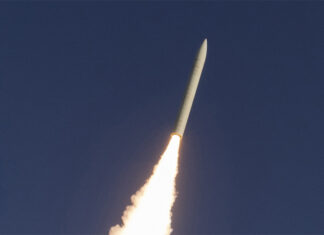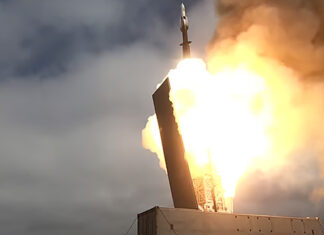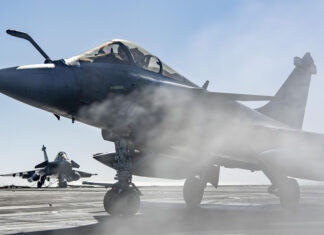
The Royal Netherlands Navy is set to acquire two new support vessels equipped with modern weapon systems and specialized equipment. Dutch shipbuilder Damen has been awarded the contract to construct these vessels.
These multifunctional support vessels will follow closely with the Air Defense and Command Frigates (LCF), offering additional defenses for them. The frigates will control weapons launched from the support vessels.
The vessels will carry new weaponry and equipment in standard ISO containers, utilizing innovative designs and smart integration of existing systems to operate with a small crew. Key features include additional long-range air defense missiles to counter mass attacks from anti-ship missiles or drones, long-range precision munitions for amphibious operations, and electronic warfare equipment to disrupt enemy radar systems and drone communications. Additionally, the vessels will be equipped with underwater drones and sensors to gather intelligence on potential threats and secure critical infrastructures in the North Sea.
The acquisition, valued between €250 million and €1 billion, depending on the content of the vessels, aligns with the Dutch government’s policy to strengthen the national Maritime Manufacturing Industry and contribute to Europe’s strategic autonomy. The first vessel is expected to be operational for North Sea missions by 2026, with both ships fully operational by 2027.

Naval Group Launches Second FDI Frigate for Hellenic Navy
Naval Group has launched the HS Nearchos, the second Defence and Intervention Frigate (FDI HN) for the Hellenic Navy, at its shipyard in Lorient, France. Designed to meet the evolving needs of modern naval warfare, the new multipurpose warship has a placement of 4,500 tonnes. It is equipped to conduct naval operations, including anti-air, anti-surface, and anti-submarine warfare. The frigate’s advanced capabilities and versatile design make it an asset for the Hellenic Navy’s maritime defense strategy. The launch of HS Nearchos follows the successful construction of the first frigate in the series and precedes the ongoing development of the third vessel, HS Formion, whose keel was laid on April 15, 2024. This project is part of a broader collaboration between the Naval Group and the Greek industry, including constructing frigate blocks in Greece under the Hellenic Industrial Participation (HIP) plan.

KONGSBERG to Upgrade Norway’s Ula-class Submarines
Kongsberg Defence & Aerospace (KONGSBERG) has secured a contract worth approximately NOK 436 million (about $41.5 million) from the Norwegian Defence Materiel Agency to upgrade Norway’s Ula-class submarines. The agreement aims to extend the operational life of these submarines until the introduction of new 212CD submarines in the 2030s.
The scope of work includes upgrades to the combat system’s software and hardware components onboard the Ula-class submarines. KONGSBERG, which initially supplied the combat system for these submarines, has previously conducted upgrade programs for the fleet. This latest modernization effort will ensure the Ula class remains operational for the next decade. The update program will maintain the Ula-class’s operational capability until the next generation of submarines arrives. KONGSBERG also supplies the combat system for future 212CD submarines, which will be delivered to Norway and Germany.
Norwegian Shipbuilder Advocates for US-Designed Constellation-Class Frigates
Norway’s Vard shipyard, a subsidiary of the Italian Fincantieri group, has recently hosted senior Norwegian officials to showcase its capabilities and argue for adopting the US-designed Constellation-class frigate for Norway’s future naval needs.

Aurora Unveils WIG Seaplane Concept for DARPA’s Liberty Lifter Program
Aurora Flight Sciences, a Boeing company, has released a new video showcasing its Liberty Lifter seaplane concept, designed for the Defense Advanced Research Projects Agency (DARPA) program. The Liberty Lifter aims to introduce new heavy-airlift capabilities from the sea by combining a ship’s transport scale with an aircraft’s speed.
The proposed X-plane demonstrator features a 65-meter (213-ft) wingspan and can carry up to 22.5 tons (50,000 lbs) of cargo. It is designed to operate at altitudes up to 10,000 ft in standard flight and utilize wing-in-ground-effect flight close to the ocean surface to extend its unrefueled range. Aurora has partnered with Gibbs & Cox, a Leidos company, to develop a flying boat capable of operating in challenging sea conditions, including taking off and landing in up to Sea State 4 and operating in ground effect up to Sea State 5, and that employs low-cost manufacturing techniques from the shipbuilding industry to demonstrate affordability.
In Phase 1B of the program, Aurora is conducting various testing activities, including tow tank testing and propeller performance characterization. The subsequent phases will involve continued development, manufacturing of the demonstrator, and flight testing, which is projected to begin in 2028.



















